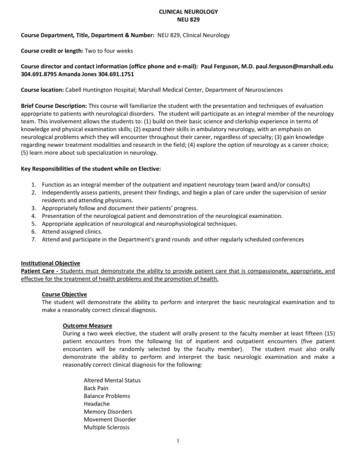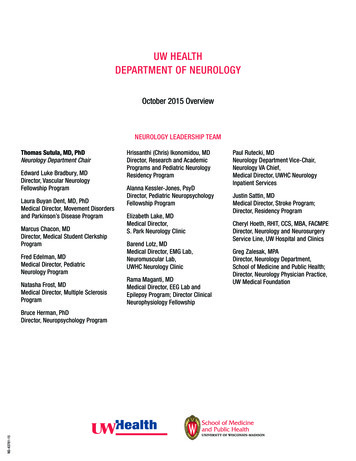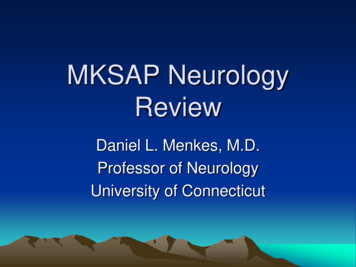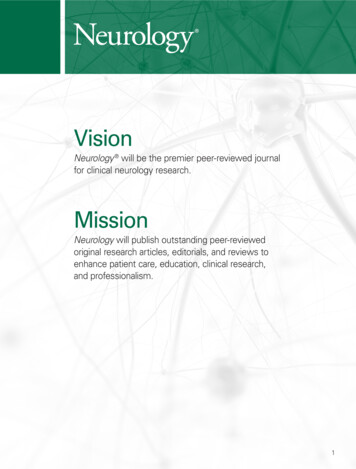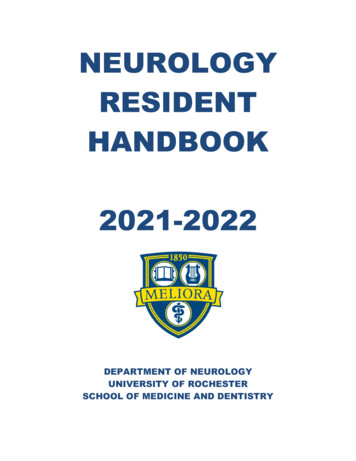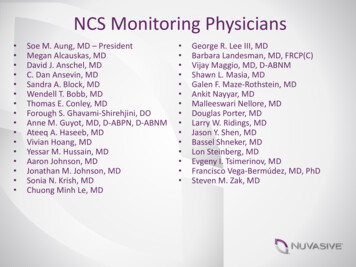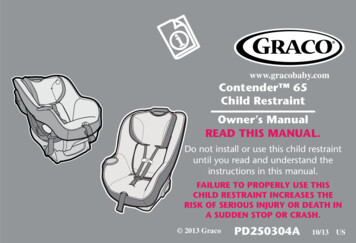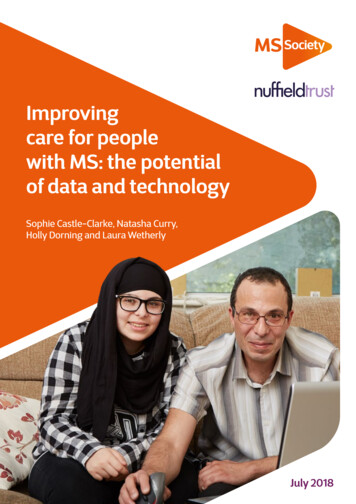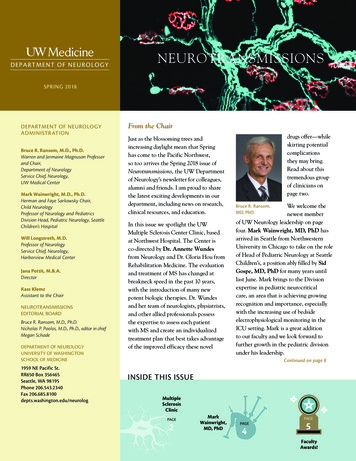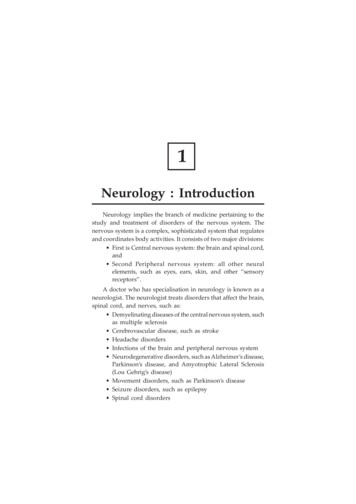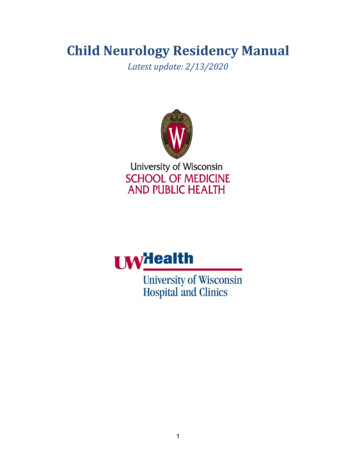
Transcription
Child Neurology Residency ManualLatest update: 2/13/20201
Letter from the Chair.4Letter from the Child Neurology Residency Director .5Program Overview .6Program Aims and Values Statement .6Overall Goals and Objectives .8Program Leadership and Committee Structure .28Resident Eligibility and Selection Process .31Emergency Neurology Prerequisites for Incoming PGY3 Residents .34Rotation and Call Schedules .37Work Hours, Leave, and Moonlighting .41Transitions of Care .47Interprofessional Communication .50Supervision Policy .53Medical Records.58Teaching Responsibilities .59Research and Other Scholarly Activities .60Faculty Mentoring .62Evaluation and Promotion.63Academic Improvement .69Misconduct .70Resident Well-Being .71Salary and Benefits .75Required Rotations .80UW and VA General Neurology Service .80UW and VA Stroke Service.86Epilepsy rotation .912
Neuromuscular Medicine .96Neurology Specialty Clinics Rotation .101Neuropathology Rotation .104Neurosurgery Rotation .107Night Float Rotation .110Inpatient Child Neurology (PGY4/5).113Outpatient Child Neurology Clinics .120Pediatric Epilepsy Monitoring Unit (PEMU) rotation .126Metabolics/Genetics Rotation .130Child Psychiatry.133Developmental Pediatrics .135Elective Rotations .140Headache Clinic .140Neuroradiology .143Research .145Neuropsychology.147Educational Conferences .150Introduction.150Mandatory Educational Conferences (PGY3) .153Mandatory Administrative Conferences (PGY 3) .155Pediatric Neurology Lecture Series (Required PGY3-5) .156PEMU/Pediatric Neurology Case Conference (Required PGY4 & 5) .157Journal Club (Required PGY4 & 5) .1583
Letter from the ChairThank you for your interest in the Neurology Residency TrainingProgram at the University of Wisconsin. Our program seeksphysicians in training who are dedicated to the care of people withdiseases of the nervous system, have demonstrated interest inclinical and basic neuroscience, and show promise of futureachievement. For more than 50 years, the Department has beendedicated to training highly motivated physicians in an atmospherethat emphasizes teamwork, close interaction with attendingphysicians and resident colleagues, independence, anddevelopment of sophisticated skills in history taking and neurological examination.The residency program is a major focus of effort for our faculty and is closely integrated with ourclinical services and clinical research programs. The current structure and organization of thetraining program was developed in 2003 and was designed to address several important needs,which were identified by the faculty as challenges for neurology training in the contemporaryenvironment. These challenges include the increasing trend toward therapeutic subspecialty carefor neurological disorders, the importance of learning in the continuity of patient care acrossinpatient and outpatient settings, and the value of placing resident trainees in close workingrelationships with teaching faculty in their areas of major expertise. These are not easy challengesto address, especially with the emphasis on short admissions and increasing outpatient care forneurological disorders, as well as the constraint of the 80-hour workweek for resident trainees.The training program organization that emerged from our efforts to address these challenges hasremained in place with minor refinements during the last few years, and includes five majorcombined inpatient-outpatient services in epilepsy, neuromuscular diseases, pediatric neurology,stroke, and general neurology. Residents on these services provide care for both inpatients andoutpatients and work closely with faculty subspecialists in each of the areas. The epilepsy andneuromuscular services also include clinical neurophysiology experience in EEG and EMG as apart of patient care in those areas. The residents on the general neurology service also care forinpatients and outpatients through coverage of the emergency room during the day and a nightfloat resident.With a rich program of noontime didactic and case conferences, weekly bedside teaching rounds,neuroimaging and subspecialty case conferences, and exposure to the breadth and depth ofclinical and basic neuroscience at the University of Wisconsin, our residency training program hasbeen an interactive and interdisciplinary experience for both our trainees and faculty. Weappreciate your interest and if you visit, look forward to introducing you in more detail to theprogram and the Department.Kathleen Shannon, M.D., FAANProfessor and Chair4
Letter from the Child NeurologyResidency DirectorWelcome to the University of Wisconsin’s Department ofNeurology and the Division of Pediatric Neurology.The Pediatric Neurology Residency Program is fully ACGMEaccredited with a current 3 year cycle. The entire training programis based at the University of Wisconsin Hospital and Clinics, theAmerican Family Children’s Hospital, and the William S. MiddletonVA Hospital. Attached to the Medical Center are state of the artfacilities which include the Health Sciences Learning Center andthe Ebling Library at the University of Wisconsin School of Medicine and Public Health.The Pediatric Neurology Division at the Department of Neurology works very closely with theDepartment of Pediatrics and provides neurological care for children in the Neurology outpatientclinics and at the American Family Children’s Hospital. This hospital is a very busy regional tertiaryreferral center which provides experience in a wide range of neurological conditions. Built in 2007and expanded in 2014, the facilities are comfortable and modern. Inpatient units consistently runnear capacity and additional intensive care units are currently being built. Pediatric neurologyfaculty participates in multidisciplinary clinics including Comprehensive Epilepsy, Neurooncology, Headache, Metabolic Genetics, Brain Care, and Neuromuscular. A very activeketogenic diet program and a recently updated pediatric epilepsy monitoring unit provide excellentopportunities to gain experience in the management of complex epilepsy patients.The pediatric neurology faculty is consistently rated highly for teaching, and neurology residencygraduates have an exceptionally high rate of passing their board exams on their first try with veryhigh scores.The University of Wisconsin, one of the top Universities in the country, offers competitivecompensation and benefits, and the city of Madison is consistently ranked as one of the bestplaces to live in the US, with natural beauty and limitless recreational opportunities. Interestedcandidates should apply through the National Resident Matching Program (NRMP). Your trainingwith us will be a very enjoyable and rewarding experience,Please contact us at residency@neurology.wisc.edu for additional questions.Our program offers a categorical position (1779185C0) guaranteeing a full 5 year course oftraining. As such, the Department of Pediatrics provides the first two years of preliminary trainingin accordance with ABPN requirements. For questions regarding the preliminary pediatric training,please contact the Pediatric Residency Coordinator, Kari Bruckner.Adam Wallace, MDProgram Director5
Program OverviewProgram Aims and Values StatementChild NeurologyProgram AimsThe UW Child Neurology Residency Program aims to:1. Attract and Train residents from a diverse set of medical schools to become clinicallyadept child neurologistsa. 100% fill rate for NRMP Match for reserved positions availableb. Institutional RITE Exam Score 50%tile for same year in training or documentedyearly improvement of at least 10%c. Board Pass Rate 90%2. Instill habits of professionalism and lifelong learninga. % Completing a research or QI projectb. % Attending a professional conferencec. % Requiring a corrective action plan3. Prepare residents for clinical or academic careers per their own preferencesa. % Pursuing fellowship trainingb. Post-graduation surveyi. Practice typeii. Preparednessc. % of residents practicing in Wisconsin after graduation4. Maintain a healthy and diverse intellectual culturea. ACGME survey questions:i. Residents can raise concerns without fearii. Culture reinforces patient safety responsibilityb. % of residents receiving formal patient safety trainingValues StatementFaculty and residents will strive to provide the highest quality of care to every patient. It is ourunwavering view that the patient comes first, and must be offered with the compassion andprofessionalism that we would expect for ourselves and our families.6
Our program emphasizes a team approach, with close interaction among attending physicians,residents, advanced practicing providers, and other health care professionals. We highly valueour culture of safety, wherein anyone can feel free to ask questions, make suggestions, or raiseconcerns without fear of reprisal.Finally, we value intellectual curiosity and rigor. We eschew hasty conclusions in favor of thetraditional form of neurological case formulation and reject reflexive decision-making in favor ofcritical reasoning and the application of sound science to patient care.Latest revision: 04/26/2018Adam Wallace7
Overall Goals and ObjectivesChild NeurologyThe overall goal of our training program is to develop superb clinical child neurologists. It is themission of our training program to ensure that our graduates have demonstrated competency inthe six core areas as designated by the ACGME.1. PATIENT CARE1.1 GoalsResidents must demonstrate the ability to provide family centered patient care that isdevelopmentally and age appropriate, compassionate, and effective for treatment ofneurological problems and the promotion of health.1.2 ObjectivesChild neurology residents will:1. Provide scientifically based, comprehensive, and effective diagnosis and management forpediatric patients with neurologic disease.2. Perform a complete history and physical examination, and generate a rational differentialdiagnosis, workup, and management plan.3. Understand how to order and interpret appropriate diagnostic tests including imaging4.5.6.7.8.9.studies, neurophysiological, genetic and metabolic tests.Make informed diagnostic and treatment decisions by analyzing and synthesizinginformation.Demonstrate technical skills that include the ability to identify and describe abnormalitieson neuroimaging studies, the ability to perform lumbar punctures and EMGs, and theability to appropriately interpret the results of imaging, EMG, EEG, and LP in the contextof patient care.Demonstrate competence in the comprehensive diagnosis and management of all formsof pediatric neurological disease.Effectively counsel patients and families.Use consultants and referrals appropriately.Understand the limits of their knowledge and expertise.1.3 Goals and Objectives by Year of TrainingPGY-3 (Adult Neurology)Goals1. Gather essential and accurate information necessary to provide comprehensive care toadult patients with neurological disorders.2. Demonstrate effective and appropriate clinical problem solving skills using evidencebased medical knowledge and sound clinical judgment.8
3. Recognize the ethical, personal and social implications of many neurological diagnosesas well as the issues surrounding predictive testing and interventions for individuals withsevere disabilities.4. Provide care to patients of varying ages and develop skills necessary to providelongitudinal care throughout the lifespan.5. The resident will develop competence at inpatient and intensive care management for avariety of adult neurological conditions. In addition, the resident will respond toconsultation requests from the UW-ER and the VA and develop skills at triaging patientsto the general or one of subspecialty services.ObjectivesResidents will:1. Develop skills in obtaining accurate historical information from patients and caregivers,with particular emphasis on ascertaining the time of stroke onset. They will be able toclearly communicate to patients and families the risks, benefits, and alternatives tointravenous and intra-arterial thrombolysis. They will learn to discuss the mechanisms ofstroke and hospital course with patients. They should also be able to counsel patientson risk factor modification and long-term outcomes.2. Learn to evaluate acute stroke patient independently, interpret neuroimaging studiesincluding CT, CTA, MRI, MRA, and catheter angiography, meet management decisionsregarding IV tPA, IA tPA and thrombectomy, learn the principles of post-thrombolysiscare and become familiar with diagnosis and management of a variety of specificcerebrovascular conditions including intracerebral hemorrhage, arterial dissection, andvenous sinus thrombosis.3. Become familiar with basic concepts of stroke rehabilitation, secondary stroke preventionand current research priorities in cerebrovascular diseases.4. Develop the skills necessary to evaluate, treat, and counsel patients and families withepileptic disorders, learn the principles of electroencephalography, and developconfidence in correctly interpreting EEG studies.5. Acquire training in diagnostic evaluation and management of patients with a widespectrum of neuromuscular disease. This will include comprehensive training inelectromyography, including advanced techniques. standard motor and sensory nerveconduction studies of upper and lower extremities and cranial nerves;- repetitive nerve stimulation techniques;- basic autonomic studies;- standard concentric needle EMG evaluations;- Single Fiber EMG techniques,- laryngeal EMG6. Achieve the following:- Learn the indications and clinical utility of muscle and nerve biopsies.- Learn how to select the muscle biopsy site to assure the highest diagnostic yield.- Understand the basic principles of muscle and nerve specimen processing (histology,histochemistry, immunostaining, electron microscopy, teased fiber analysis).- Be able to incorporate the biopsy results into the clinical decision-making process withregard to diagnosis and management of patients with neuromuscular disorders.- Have an opportunity to assist in muscle and nerve biopsies (in the operating room, or inthe neurology outpatient clinic for needle muscle biopsies).9
-Develop understanding for the clinical utility and limitations of different electrodiagnostictests in evaluation of patients with various neurological disorders.7. Acquire a basic working knowledge of the surgical management of diseases of thenervous system, which is essential to the neurologist-in-training. The neurologists mustbe aware of indications for, limitations of, and possible complications of surgical treatmentif they are to make appropriate referrals and counsel their patients wisely.8. Be provided with learning opportunities to manage patients with neurological disease whorequire intensive care.9. Develop skill in discussing end-of-life issues with patients with neurological diseases.10. Become proficient in the management of patients with disorders of intracranial pressure.11. Learn to identify and classify abnormal movements (tremor, chorea, myoclonus, etc.),demonstrate working differential diagnosis of all movement disorders and understanddistinguishing clinical features.12. Learn appropriate work-up for major neurologic symptoms/syndromes/diseases.13. Implement a reasonable treatment plan.
the Ebling Library at the University of Wisconsin School of Medicine and Public Health. The Pediatric Neurology Division at the Department of Neurology works very closely with the Department of Pediatrics and provides neurological care for children in the Neurology outpatient clinics and at the American Family Children’s Hospital.
